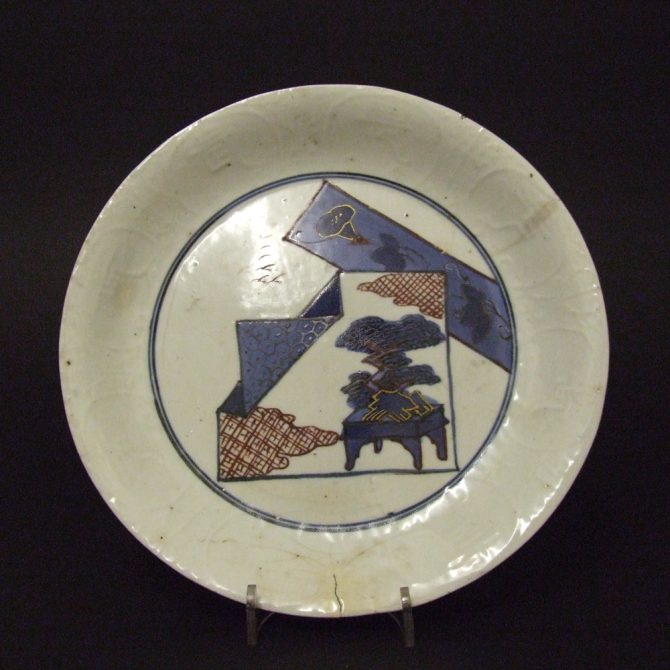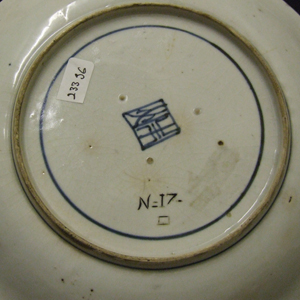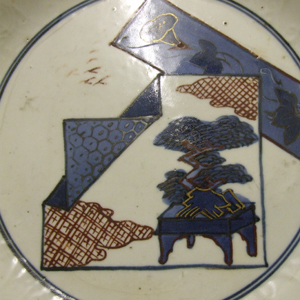
ARITA c.1655 – 1670 Japanese Porcelain
A Rare Early Japanese Porcelain Dish from the Collection of Augustus the Strong, Arita Kilns c.1655-1670, Acquired by Augustus the Strong in 1721. Decorated in Underglaze Blue, Iron Red, Silver and Gilding. The Design Consists of a Piece of Shikishi (special paper reserved for painting or calligraphy) with Either Another Piece of Paper or Possibly a Strip of Material. The Folded Shikishi is Decorated with a Bonsai Tree in a Pot with Cloud Shaped Patterns. The Strip of Paper or Material is Painted with Flowering Convolvulus. The Border has Moulded Raised Moulded Decoration Including Large Single Characters.
SOLD
- Condition
- There is a crack to the rim about c.32 mm long at about 2 O'clock, this has a stain which is grey in colour. There is a firing crack at 6 O'clock which has some crazing around it with associated pale red/brown staining. The well has a long glaze crack c.90 mm long. There are a few other minor stains but the general appearance is brighter than in the photograph.
- Size
- Diameter : 21 cm (8 1/4 inches)
- Provenance
- Augustus the Strong (1670 - 1733). The Royal Collection at The Japanese Palace, Dresden, Wheel Engraved Johanneum Inventory Mark to the Base N : 17 Followed by a Square. The Square Represents the `Krack` section of the inventory, this Japanese dish appears to come under Chapter IV. Table services of 1721.
- Stock number
- 23396
Information
This early Arita polychrome dish is an object that was made for the domestic market but it is clear that such objects were being bought back by European merchants in small numbers. Early collections such as thous of Burghley House (The Burghley Porcelains, An Exhibition from The Burghley House Collection and Based on the 1688 Inventory and 1690 Devonshire Schedule, Japan Society, New York,1986) contain Japanese porcelain of this type. This dish would have been second hand by the time it reached Augustus the Strong, this is unusual as most of his porcelain was bought as new.
This dish is one of a number of dishes from this period with the sparing use of a strong iron red and gilding over underglaze cobalt blue. I think it might be possible considered this group as the precursors to imari porcelain.
Augustus The Strong :
Augustus II (1670-1733) King of Poland and Elector of Saxony known as Augustus the Strong. Augustus`s great physical strength earned him the nicknames `the Strong`, `Saxon Hercules` and `Iron Hand`. He liked to show that he lived up to his name by breaking horse shoes with his bare hands. His ancestor Cymburgis of Masovia was also noted for her strength. Augustus the Strong owed allegiance to the Imperial Habsburgs as a member of the Order of the Golden Fleece. Augustus the Strong owed allegiance to the Imperial Habsburgs as a member of the Order of the Golden Fleece. As Elector of Saxony, he is perhaps best remembered as a patron of the arts and architecture. He established the Saxon capital of Dresden as a major cultural centre, attracting artists and musicians from across Europe to his court. Augustus also amassed an impressive art collection and built fantastic baroque palaces at Dresden and at Warsaw. As a politician, he is nowadays not held in high esteem in Poland, getting blamed for embroiling the Polish-Lithuanian Commonwealth in the Great Northern War. His attempts at internal reforms and at bolstering the royal power are considered to have come to naught, while his policies are said to have allowed the Russian Empire to strengthen its influence over the Polish-Lithuanian Commonwealth.
The Japanisches Palais (Japanese Palace) is a Baroque building in Dresden, Germany, on the Neustadt bank of the river Elbe. Built in 1715, it was extended from 1729 until 1731 to store the porcelain collection of Augustus the Strong that is now part of the Dresden Porcelain Collection. However, it was never used for this purpose, and instead served as a library.

